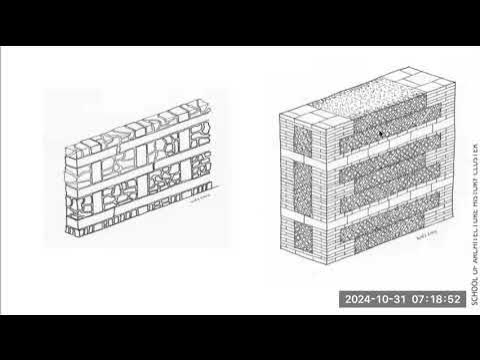The Pantheon - Under the Dome
Summary
TLDRThe Pantheon, built in 118 AD, is one of the most important architectural achievements in history. Roman engineers revolutionized construction with their use of durable concrete, creating a massive dome 142 feet in diameter. To support the dome, they used progressively lighter materials, such as volcanic pumice, at higher levels, culminating in a 30-foot Oculus at the top, which also allowed light into the temple. This innovative design made the Pantheon the largest unreinforced concrete dome in the world, influencing architecture for centuries, even inspiring modern buildings like the New York State Supreme Court.
Takeaways
- 🏛️ The Pantheon is considered one of the most important buildings ever constructed, revolutionizing architecture.
- 🛠️ Roman technology transformed lime mortar into strong, durable concrete, which played a pivotal role in their architectural advancements.
- 🏗️ The Pantheon was built around 118 AD and is renowned for its awe-inspiring dome, which was an architectural feat of its time.
- 🌍 The building was originally constructed as a temple for the 12 main gods of Roman religion, although it is no longer used for worship.
- 🌀 The dome of the Pantheon measures 142 feet in diameter, a massive achievement in the 2nd century.
- 🏋️ Roman engineers innovated by using a variety of stone types in the concrete, making the dome lighter at the top and stronger at the base to ensure stability.
- 🧱 The base walls supporting the dome are 20 feet thick, which helps stabilize the structure under the outward push of the dome's weight.
- 🪵 Carpenters and masons built the dome in layers, using lighter stones at higher levels and a wooden framework to support the construction.
- 🔆 The oculus, a 30-foot hole at the apex of the dome, reduces weight at the top and allows light to enter the Pantheon.
- 🏛️ Even after 2,000 years, the Pantheon remains the largest unreinforced concrete dome in the world and continues to influence modern architecture.
Q & A
What material did Roman engineers transform to revolutionize architecture?
-Roman engineers transformed lime mortar into durable concrete, revolutionizing architecture.
Why is the Pantheon considered one of the most important buildings in the world?
-The Pantheon is considered one of the most important buildings due to its advanced engineering, its massive dome, and its lasting influence on architecture.
When was the Pantheon in Rome built?
-The Pantheon was built in 118 AD during Emperor Hadrian's reign.
What unique architectural feature does the Pantheon have?
-The Pantheon features a massive dome 142 feet in diameter, which was an extraordinary engineering feat for its time.
How did Roman engineers prevent the dome from collapsing after removing scaffolding?
-They used lighter materials as the dome’s layers got higher, transitioning from heavy basalt rock at the base to lightweight volcanic stone (pumice) at the top.
What is the function of the 30-foot hole at the apex of the Pantheon’s dome?
-The 30-foot hole, called the oculus, reduces the load on the dome's weakest point and allows light into the Pantheon's interior.
How did the Pantheon's dome influence future architectural designs?
-The Pantheon's dome influenced later architectural designs, such as the Duomo in Florence and the New York State Supreme Court building, due to its scale and engineering innovations.
What material did Roman engineers use at the top of the Pantheon’s dome to lighten the structure?
-They used pumice, a lightweight volcanic stone, at the top of the dome to lighten the structure.
Why were the Pantheon's base walls built 20 feet thick?
-The base walls were built 20 feet thick to support and buttress the dome, preventing it from pushing outward and collapsing.
What makes the Pantheon’s dome stand out compared to modern domes?
-The Pantheon’s dome is still the largest unreinforced spherical concrete dome ever built, a feat not matched until 1,300 years later with the construction of the Duomo in Florence.
Outlines

Dieser Bereich ist nur für Premium-Benutzer verfügbar. Bitte führen Sie ein Upgrade durch, um auf diesen Abschnitt zuzugreifen.
Upgrade durchführenMindmap

Dieser Bereich ist nur für Premium-Benutzer verfügbar. Bitte führen Sie ein Upgrade durch, um auf diesen Abschnitt zuzugreifen.
Upgrade durchführenKeywords

Dieser Bereich ist nur für Premium-Benutzer verfügbar. Bitte führen Sie ein Upgrade durch, um auf diesen Abschnitt zuzugreifen.
Upgrade durchführenHighlights

Dieser Bereich ist nur für Premium-Benutzer verfügbar. Bitte führen Sie ein Upgrade durch, um auf diesen Abschnitt zuzugreifen.
Upgrade durchführenTranscripts

Dieser Bereich ist nur für Premium-Benutzer verfügbar. Bitte führen Sie ein Upgrade durch, um auf diesen Abschnitt zuzugreifen.
Upgrade durchführenWeitere ähnliche Videos ansehen
5.0 / 5 (0 votes)






